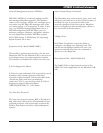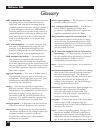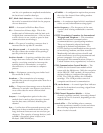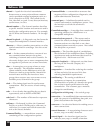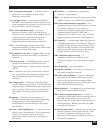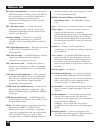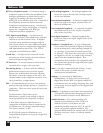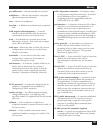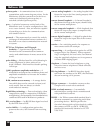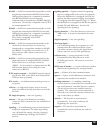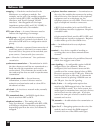
Glossary
259
ms, millisecond — One-thousandth of a second.
multiplexor — A device that divides a composite
signal among several channels.
mux — Short for multiplexor.
mux link — A Multiserver-to-feeder-mux composite
link.
NAK, negative acknowledgment — A control
character which indicates that the previous
transmission block was received in error.
node — Any Multiserver or feeder mux in the
Multiserver network. Each node has a unique
name (ID) and number.
node reset — Resets the unit to either the current
configuration (warm start) or to the factory
defaults (cold start).
nonvolatile — A term used to describe a data
storage device (memory) that retains its
contents when power is lost.
null character — A character (usually all bits set to
Mark) used to allow time for a printer’s
mechanical actions to take place so that the
printer will be ready to print the next data
character. Sometimes called idle character.
NULL password — A password configured for no
password. A password can be deleted by
configuring a NULL password.
number of rings — An OPX-strapped switching-
configuration option. On outgoing calls,
specifies number of ringbacks before the second
dial tone.
off-hook — A line condition caused when a
telephone handset is removed from its cradle, if
the line is active.
on-hook — A line condition that exists when a
telephone handset is resting in its cradle, if the
line is active.
OPX, off-premises extension — In industry usage,
an off-premise telephone extension. As related
to the Multiserver voice/fax module, a
strapping option for compatibility with the
station side of a voice PBX.
pad character — A character inserted to fill a blank
time slot in a synchronous transmission or to
fulfill a character-count requirement in a
transmission of fixed block length. Leading pad
characters help establish synchronization, and
trailing pad characters prevent the dropping of
the RLSD/RTS signal too soon after the end of
a frame.
parity, parity bit — A bit added to a character to
ensure that the total number of ones in a
grouping of bits is either always even for even
parity, or odd for odd parity. This permits
detection of signal errors.
Part 15, FCC — A part of the FCC body of rules that
defines the restrictions to the level of
electromagnetic emissions for an electronic
device.
Part 68, FCC — A part of the FCC body of rules that
defines the technical requirements that an
electronic device must meet before it can be
connected to the telephone network.
PBX, private branch exchange — A privately owned
phone system installed within the premises of
an organization. It allows communication
among users within the organization, as well as
between those users and the outside world. It
differs from a key telephone system in that the
user must dial an access number, such as 9, to
get an outside line.
PDN, public data network — A network established
and operated by a PTT, common carrier, or
private operating company for the specific
purpose of providing data-communication
services to the public.
PLARC, private line automatic ringdown
circuit — A typical voice application where KTS
is configured at both ends. When one handset
is lifted, the other one rings.



